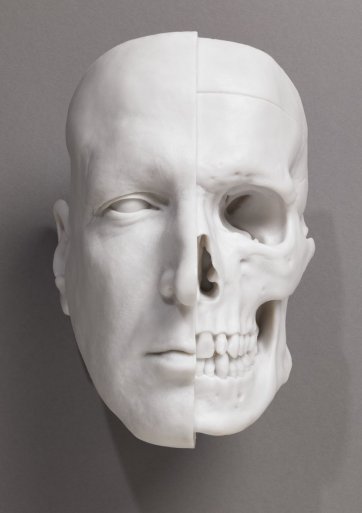Sam Jinks on hyper realism and his motivations.
I would argue that my work is not particularly realistic. In the process of making it, you do have to move reality around a bit and try and step out of that kind of the hyper, hyper real. So yeah, sculptures sort of changed for me over the years. So when I was younger it was just the act of making a cool object. And now it seems much more like a meditation and a way of understanding the world. Yeah. My dream as a child was always to work in film. Obviously we've seen Ghostbusters and all these fantastic films. As a young person I would often make, try and make these things. And in the shed and at home. I sort of had a sensibility, I think that was a little bit outside of the contemporary art world. I didn't go to art school. I just worked and drew and made things but I think the life experience I'd had there'd been some major hiccups in my mid twenties where I had some real challenges. I had a different perspective going through that. So I had this sort of vision of my own own head but looking at it as an adult and realising what it meant. And also the contrast between the two objects you've got the head that's alive and the head that's no longer with us and kind of combining the two as if life can easily be, either or, at any given time. And the unknown of the right hand side of the skull. The process is basically you sculpt the piece in clay as you can see clay things here and get it as accurate as you can. I did take a life cast of my own head and I did have a dental cast as well, and a dental x-ray which was made it even more disturbing. And I foolishly took a cast of my own eyeball, which I wouldn't recommend. I wouldn't do it again, but just with Alginate, which is like a dental, it reasonably safe, but it was uncomfortable. I just wanted to get the set of the eye as accurate as I could. And it meant I could get the size of the eye ball. A self portrait is difficult. The strange thing is now though, that when I look at it I'm looking at a younger person. And so it has another issue it's like that's confronting as well. Yeah, I think sometimes it's liberating as well because you look at yourself and go, okay, well this is who I am. There's nothing I can do about that. So just be who you are, but yeah, it is confronting. Yeah, definitely. I'm always struck by the things where the rhythm of life or the cyclic nature of life is demonstrated. And I think in nature, you see it a lot. I think I've, as time goes on I'm experiencing that more and more. Even though something can die, it's kind of fed immediately back into the growth, the movement. And so things like that, woman and child sculpture, again was an example of a book ended life where you've got both the beginning and the end in harmony in some way. Also, I like the idea of making it as a symbol as well. So you've got something like a crucifix which is on one hand, kind of it's kind of a horrific image really, but people put them in their homes and they give tremendous comfort. I mean, eternal life even. So what more powerful an image or an object is that? And I think wouldn't it be great to be able to make a sculpture that had those properties. It's almost like magical properties. The go beyond just a nice object or something to put in the fancy apartment. I don't know. So I think the themes always go back to that. I always like symbols. Symbols that kind of allude to something. And I like the idea that it offers something else and I don't always get it. Sometimes I get close to it and the dream is one day I'll nail it, but we'll see.
Related people
Related information



Dissections
Layered portraits from the collection
Previous exhibition, 2016This display sets two impressive portraits from the collection into direct dialogue: Sam Jinks’ sculptural self portrait and Nick Mourtzakis’ painted portrait of David Chalmers, along with related maquette and sketches.Together they explore physical and psychological manifestations of the strata of self-hood.



The Gallery
Visit us, learn with us, support us or work with us! Here’s a range of information about planning your visit, our history and more!



Support your Portrait Gallery
We depend on your support to keep creating our programs, exhibitions, publications and building the amazing portrait collection!






